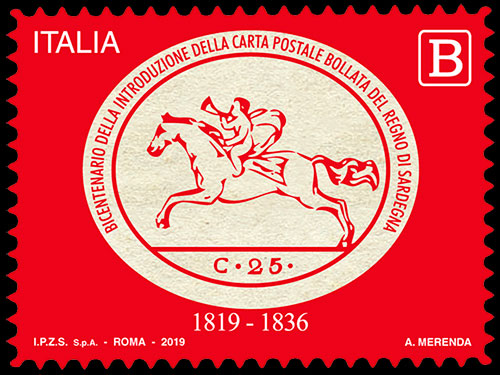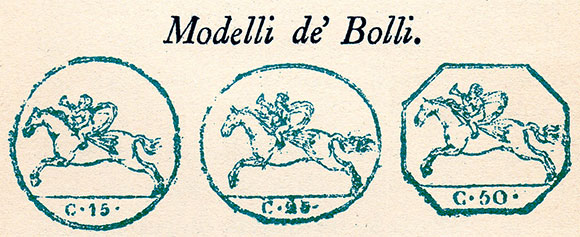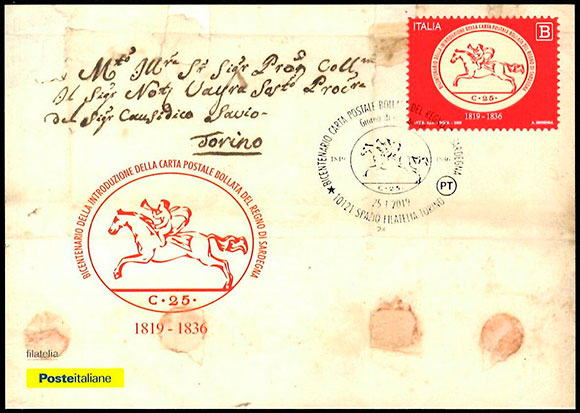
On January 25, 2019, the Italian Post Office issued a postage stamp commemorating the 200th anniversary of the "Sardinian Horses," the predecessor of Sardinia's postage stamps.
On August 12, 1818, the Kingdom of Sardinia issued a new Postal Regulation, which established the basic principles for the development of the Royal Postal Service, enshrined tariff reductions, and regulated the rules for mail delivery by private couriers. At that time, the Royal Post poorly met the social and economic needs of residents, leading to the emergence of numerous private organizations whose messengers and couriers delivered mail faster and more affordably than the Royal Post.
To control private mail delivery, the new Postal Regulation introduced a special fee for permission to deliver letters. A separate Manifesto of November 7, 1818, established the "Carta bollata postale"—special sheets of letter paper measuring approximately 40 x 26 cm, folded in half, and bearing a special postmark. Anyone who purchased a postmarked sheet could choose to have their letter sent to either the post office or a private messenger or courier, without violating the Royal Mail monopoly. Naturally, in addition to the fee for the permit, the sender also paid the cost of delivery.
Thanks to the distinctive image on the postmark—a small horseman with a posthorn sitting astride a galloping horse—these postmarked sheets acquired their own established name: "Sardinian Horses" (Italian: "Cavallini di Sardegna" or "Cavallini Sardi"), a name that stuck with both the sheets and the postmark.

The postcard sheets with Sardinian horses are one of the first known pre-paid postage stamps. The postmark on the sheet served as evidence of pre-payment for delivery authorization. This circumstance gives the postcard its reputation as the precursor of the postage stamp, as even then it performed the postage stamp's primary function—pre-payment for letter delivery.
In accordance with the tariffs in force at the time, which depended on the distance the letter was being sent, three postmarks were issued:
- A round postmark with the inscription "C - 15" corresponded to a rate of 15 chenzim – letters were delivered up to 15 miles.
- An oval postmark with the inscription "C - 25" corresponded to a rate of 25 chenzim – letters were delivered up to 25 miles.
- An octagonal postmark with the inscription "C - 50" corresponded to a rate of 50 chenzim – letters were delivered up to 35 miles.
There were two issues of the "Carta postale follata" in total. The first issue of "Sardinian Horses" was published on January 1, 1819, and remained in circulation until January 31, 1820. The stamp was applied in blue ink to various types of paper, both with and without watermarks. The second issue was issued on January 1, 1820, and remained in circulation until May 30, 1836. This time, the stamp design, application methods, and color changed: the stamp became colorless, applied to paper by embossing, and only paper with watermarks (the inscription "General Directorate of the Royal Mail" and the coat of arms) was used. The stamp frame design also changed slightly.
In 1836, "Sardinian Horses" postcards were withdrawn from postal circulation. However, the horses did not disappear completely from the lives of philatelists. They still appear on Italian postage stamps, envelopes, and special cancellation marks, and are also used as logos by organizations associated with postal and philately. The cancellation mark featuring the Sardinian horse, along with the inscription "First Day of Issue," is used on Italian postal stamps.
Designer Angelo Merenda chose the oval cancellation mark "C - 25" from the first issue of Sardinian Horses in 1818 as the design for the commemorative postage stamp. A commemorative text in Italian is placed around the stamp outline. The stamps were printed in a print run of 2 million copies in sheets of 45 stamps. The stamp's face value is "B," equivalent to €1.10. A first day cover and a special commemorative cancellation mark were also issued.

Перейти в каталог
I apologize for any errors or inaccuracies


